| Rosa hirtula | |
|---|---|
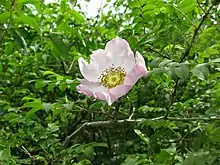 | |
| At the Hakone Botanical Garden of Wetlands | |
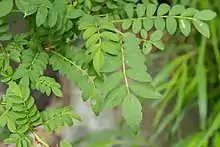 | |
| Foliage | |
| Scientific classification | |
| Kingdom: | Plantae |
| Clade: | Tracheophytes |
| Clade: | Angiosperms |
| Clade: | Eudicots |
| Clade: | Rosids |
| Order: | Rosales |
| Family: | Rosaceae |
| Genus: | Rosa |
| Species: | R. hirtula |
| Binomial name | |
| Rosa hirtula | |
| Synonyms[1] | |
| |
Rosa hirtula, the sanshou-bara or Hakone rose, is a species of flowering plant in the family Rosaceae.[2][3] It is found only in the vicinity of Mount Fuji and neighboring Mount Hakone in Japan, and is the town flower of Hakone.[4][5]
The pale pink, single flowers can be as wide as 7.5 cm (3 in).[3] Quite unusually for a rose, it can take on a tree-like growth form,[6] and reach up to 1–6 m (39–236 in) tall. It has 4-9 pairs of leaves, the leaflets are each 1–3 cm (0–1 in) long. It flowers between May and June.[7]
The causal fungus of a rust disease of Rosa hirtula was thought to be a common species Phragmidium rosae-multiflorae. After a study in 2019, it was concluded that it was a species distinct from P. rosae-multiflorae; and a new name, Phragmidium satoanum, was proposed for it.[8]
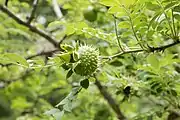 Unripe hip
Unripe hip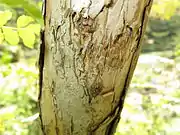 Bark tends to peel[3]
Bark tends to peel[3]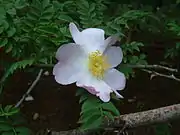 Detail of petal venation and anthers
Detail of petal venation and anthers
References
- ↑ "Rosa hirtula (Regel) Nakai | Plants of the World Online | Kew Science". Plants of the World Online. Retrieved 30 September 2023.
- ↑ Tsuyuzaki, Shiro (2021). "Rosa hirtula (Regel) Nakai". hokudai.ac.jp. Hokkaido University. Retrieved 6 August 2022.
Sanshoubara (サンショウバラ, 山椒薔薇)
- 1 2 3 "Rosa hirtula (S)". The Royal Horticultural Society. 2022. Retrieved 6 August 2022.
Synonyms; Rosa roxburghii var. hirtula ... 1 suppliers
- ↑ "Rosa hirtula (Regel) Nakai". Plants of the World Online. Royal Botanic Gardens, Kew. Retrieved 6 August 2022.
- ↑ "Fuji-Hakone-Izu". Japan National Tourism Organization. Ministry of the Environment, Government of Japan. Retrieved 6 August 2022.
unique to the area ... sansho-bara
- ↑ Ohba, Hideaki (2016). "840. Rosa hirtula". Curtis's Botanical Magazine. 33 (3): 226–234. doi:10.1111/curt.12152.
- ↑ "Rosa roxburghii var. hirtula". treeflower.la.coocan.jp. Retrieved 15 February 2020.
- ↑ Ono, Yoshitaka Wahyuno (2019). "Phragmidium satoanum, a new rust pathogen of Rosa hirtula in Japan". Mycoscience. 60 (4): 237–245.